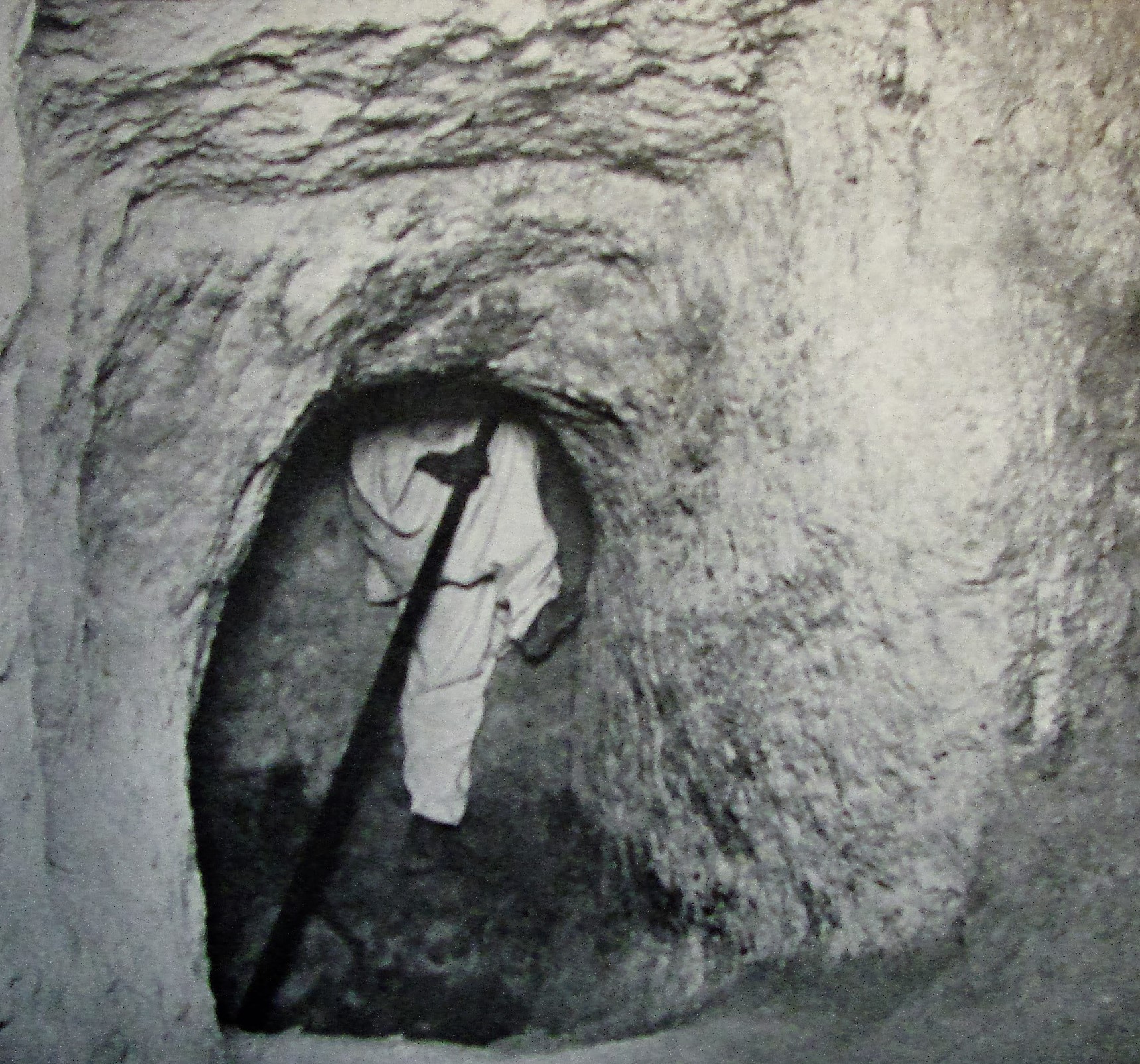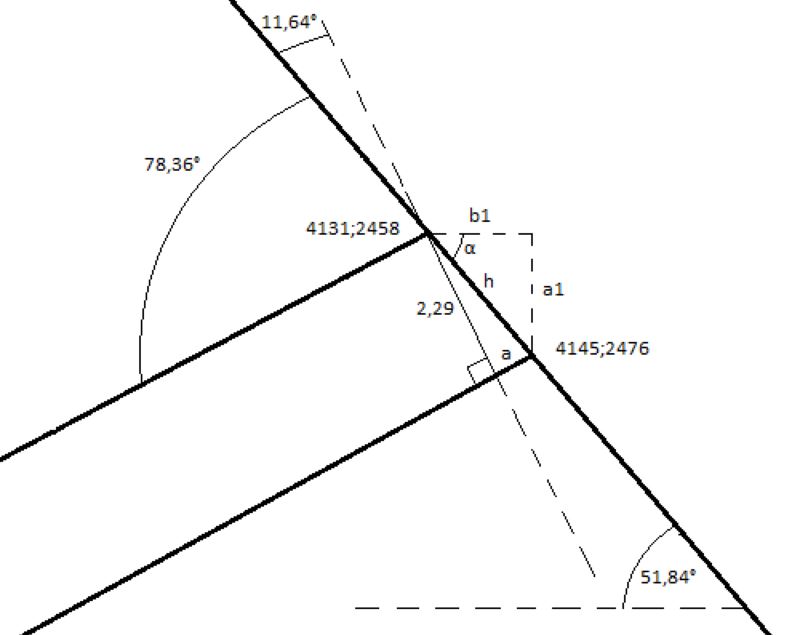The Descending Passageway
Section 5.2.1
Please observe the base line of the pyramid is theoretical. In reality the bedrock has only been leveled partly. In the middle remains a knoll. We can only guess the dimensions of the knoll, but we know for sure the bedrock is not leveled completely. When you see the complete construction of the pyramid and the great efforts the Egyptians made, it is out of the question the knoll was left as it was due to laziness or time pressure. There might have been a very good reason to build the pyramid exactly there - on the knoll.
The little black spot is an opening to a little westward passage, which is connected to a shaft which leads upwards to the Gallery.
Underneath you can see a picture of the little passage viewed against the western wall in the descending passageway.

Source: The Great Pyramid Passages And Chambers" Volume 1 by John and Morton Edgar, 1910
The worm.
Section 5.2.2
In a tent at the pyramid in Gizeh Morton Edgar wrote a letter on 16th June, 1909 to Brethren that he mentioned that he had to remove some concrete for a measuring purpose in the floor corner at the eastern wall at the end of the descending passageway. He discovered the concrete was "natural" formed by the limestone dust and caked by the rain. When he removed the concrete gently with a chisel he all of a sudden saw a living worm completely embedded in it. He wrote: "It was nearly three inches long, flat in section, hard, and of an ivory colour". Source: The Great Pyramid Passages And Chambers" Volume 1 by John and Morton Edgar, 1910. (S1-[S293]-P145-L44).
It is a surprise an animal can live in this environment.
Section 5.2.3
Underneath you can see the measuring details of the descending passageway. The Apex is the center of the pyramid in the North - South direction. (The very small figures are for my use only).
There might be small measuring errors on the measured values (RM). Different sources might have different measuring values, it is not possible to measure the lengths, widths and heights with a high precision in the pyramid mainly due to the rough sides of the passageways and chambers, but also due to the temperature changes as mentioned by Sir William Matthew Flinders Petrie, who is one of my sources.
Flinders Petrie:
"Having, then, fixed the original position of the doorway of the Pyramid, we may state that it was at 668,2 ± 0,1 above the pavement of the Pyramid"
(S5orig-[S35]-P55-L4)
My comments to Petrie:
668,2"
+/- 0,1"
= 32,4 cubits +/- 0,005 cubits
(= 45,426 remens +/- 0,007 remens)
Piazzi Smyth comments the perpendicular height of the descending passageway:
In the table page 36 in the source S20:"Mean height 47,24" "
My comments to Smyth:
47,24" = 2,29 cubits RM
Flinders Petrie:
"The absolute position, then, of the middle of the S. end of the entrance passage floor will be, in level, 668,2 - (4140 x sin 26° 31´ 23´´ ) - ,8 difference of floor offsets,
= -1181 +/- 1 ?"
(S5orig-[S37]-P59-L6-8)
My comments to Petrie:
The length of the descending passageway on floor level is 4140" = 200,78 cubits RM
The elevation of the descending passageway is 26° 31´ 23´´ = 26,5231° RM
It is interesting as the horizontal length of the descending passageway at the floor level is 114,72 cubit + 64,92 cubit = 179,64 cubit.
The vertical length of the descending passageway at the floor level is 57,26 cubits + 32,4 cubits = 89,66 cubits.
For the ancient Egyptian architect the elevation was 179,64 x 7 hands / 89,66 cubits = 14 seked.
So, every time they stepped 2 cubits southwards horizontal, the passageway declined 1 cubit vertical. Very simple and easy to build.
My comments to Petrie:
-1181" +/- 1" = -57,27 cubits +/- 0,048 cubits.
Here is the difference between the calculation method in 1880 and a Texas Instruments TI-30. The correct calculated result is -57,26 cubits.
Underneath I have issued a detailed drawing of the entrance.
Calculations:
(The half of the length of the pyramid base is 220 cubits NM and the height is 280 cubits NM.)
180° - 38,16° - 63,48° = 78,36°
Coordinates:
4400;2800 - 255;0 = 4145;2800
4145;2800 - 0;324 = 4145;2476 which is the entrance coordinate in the outer casing at floor level.
Section 5.2.4
We look closer to the entrance:
The mentioned perpendicular height of the descending passageway of 2,29 is in cubits RM.
The virtual line which is perpendicular to the floor and the roof deviate from the casing by: 90° - 78,36° = 11,64°
The length of the casing from the entrance floor to the entrance roof is:
h = 2,29 cubits RM / cos 11,64°
h = 2,34 cubits
b1 = 2,34 cubits x cos 51,8428° as the angle α is 51,8428°
b1 = 1,45 cubits
(To show the calculation I need another typing.)
The coordinate of the intersection between the roof and the outer casing is:
4145 - 14; 2476 - 18 = 4131;2458 (as 1 cubit is 10 in the coordinates.)
"4140"
(S5orig-[S36]-P58-L30 in the table)
My comments:
4140" = 200,78 cubits RM = 283.94 remens RM
(Sometimes I mention the distance in remens as I suspect this unit has been used here and there instead of cubits).
The overview of the descending passageway:
Calculations:
32,4 cubits / sin 51,8428° = 41,20 cubits200,78 cubits RM x cos 63,4769° = 89,66 cubits, (which is 32,4 cubits + 57,26 cubits)
32,4 cubits x tan 63,4769° = 64,92 cubits
64,92 cubits + 25,45 cubits = 90,37 cubits
200,78 cubits RM - 72,56 cubits = 128,22 cubits
Flinders Petrie:
"
The absolute position, then, of the middle of the S. end of the entrance passage floor will be, in level, 668,2 - (4140 x sin 26° 31´ 23´´ ) - ,8 difference of floor offsets,
= -1181 +/- 1 ?
; in distance from N. base of pyramid 524,1 + 3704,3 = 4228 +/- 2 ? or 306 N. from mid-plane ; "
(S5orig-[S37]-P59-L6-9)
My comments to Petrie:
524,1" = 25,42 cubits
3704,3" = 179,65 cubits = (254,06 remens)
4228" +/- 2" = 205,04 cubits +/- 0,1 cubits = (289,98 remens +/- 0,14 remens ~ 290 remens)
306" = 14,84 cubits = (20,99 remens ~ 21 remens)
The comments from Flinders Petrie in bold with measures in cubits and with a little help for the understanding, reads:
"In distance from North base of pyramid 25,42 cubits + 179,65 cubits = 205,04 cubits +/- 0,1 cubits"
The correct calculated lengths are 25,45 cubits + 114,72 cubits + 64,92 cubits = 205,09 cubits, a little diversion of 0,05 cubits, which is under our accuracy in this work.
"or 14,84 cubits North from mid-plane"
The midplane is 220 cubits NM and the most Southern coordinate at the floor is 2349;3373. The distance from mid-plane (or Apex) is:
234,90 cubits - 220 cubits NM = 14,90 cubits, a diversion of 0,06 cubits , which again is under our accuracy in this work.
Coordinates:
4400-904; 2800 = 3496;2800 is the point where the floor of the descending passageway hits the virtual horizontal base of the pyramid.
The vertical height in the descending passageway is : 2,29 cubits RM / cos 26,5231° = 2,56 cubits
3496; 2800-26 = 3496;2774 is the point in the roof vertical to the above coordinate.
3496; 2800+573 = 3496;3373
3496-1147; 3373 = 2349;3373 is the point in the floor where the descending passageway hits the horizontal floor.
2349; 3373-26 = 2349;3347 is the point in the roof vertical to the above coordinate.
2349 - ( 10 x 2,29 cubits RM x sin 26,5231° ) ; 3373 - ( 10 x 2,29 cubit RM x cos 26,5231° ) = 2339;3353 is the point in the roof where the descending passageway hits the horizontal roof.
Section 5.2.5
For 3D designers:
The theoretical floor line is:
y = -0,49944x + 4546,19 based on the coordinates 2349;3373 to 4145;2476
The theoretical roof line is: y = -0,49888x + 4518,86 based
on the coordinates
2349;3347 to 4131;2458
(Accuracy for the theoretical lines are +/- 0,1 cubit or +/- 1 pixel)
Top view:
Section 5.2.6
Flinders Petrie:
"and its middle 287,0 +/- ,8 E. of the centre of the Pyramid".
(S5orig-[S35]-P55-L6)
My comments to Petrie:
287,0" +/- 0,8" = 13,92 cubits +/- 0,04 cubits
The comments from Petrie with cubits, reads:
In my drawings underneath I have used the value 13,92 cubits (or 139 pixels to calculate the East-West coordinate) :
The midplane is located at 220 cubits NM, which gives the East-West; North-South coordinate 2200;4400 , where the coordinate 0;0 is in the East - South corner.
As stated in section 5.2.4 the North - South coordinate is 4145.
In section 5.3.2 Flinders Petrie measured the width of the descending passageway to 32,9" = 1,98 cubits RM.
(1,98 cubits RM is 20 pixels in the drawings ).The
East-West; North-South
coordinate for the entrance on the floor level is:
Mid of the entrance or descending passageway: 2200 - 139 = 2061
Western wall: 2061 - 10; 4145 = 2051;4145
Eastern wall : 2061 +10; 4145 = 2071;4145
Underneath is a view from the top of pyramid:
Section 5.2.7
And closer:



